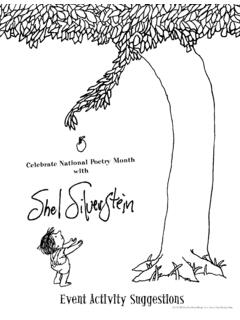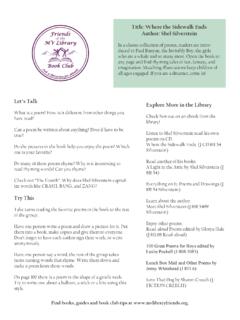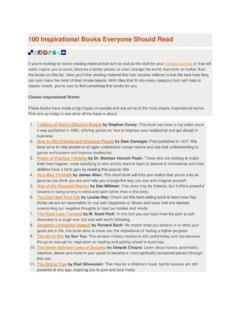Transcription of About the Book - Shel Silverstein
1 About the from Every Thing On It. 2011 Evil Eye, LLC. All rights reserved. Permission to reproduce and distribute this page has been granted by the copyright holder, HarperCollins Silverstein is the author-artist of many beloved books of poetry and prose, including Where the Sidewalk Ends; A Light in the Attic; Falling Up; The Missing Piece; The Missing Piece Meets the Big O; Lafcadio, the Lion Who Shot Back; A Giraffe and a Half; Don t Bump the Glump; and Runny Babbit: A Billy Sook. He was also a cartoonist, playwright, poet, performer, recording artist, and Grammy-winning, Oscar-nominated songwriter. You can learn more About shel and his books by visiting Moyer 1985 by Evil Eye, LLCB efore ReadingRead aloud several poems from authors such as Jack Prelutsky, Lilian Moore, Nikki Giovanni, Mary Ann Hoberman, or Eve Merriam.
2 Create a list of these poems characteristics. Have students note the rhythm, rhyme, format, and content of these poems. Then read aloud several poems from Every Thing On It. Create a list of the characteristics of Silverstein s poems. Discuss the similarities and differences between his poetry and the poems of the authors listed above. Help the students begin to define Silverstein s unique style. After working with the poems in Every Thing On It, students will be able to describe Silverstein s style more readily, so be certain to revisit this list with the students after reading the will rhyme, giggle, snicker, and wiggle as they read this brand-new collection of shel Silverstein s original, entertaining poetry.
3 Every Thing On It comprises more than one hundred never-before-published poems and illustrations collected from Silverstein s personal shel SilversteinClassroom ActivitiesIllustrations from Every Thing On It. 2011 Evil Eye, LLC. All rights reserved. Permission to reproduce and distribute this page has been granted by the copyright holder, HarperCollins What s So Funny? Ask students: What things make you laugh? Why? Have students read through the poems in Every Thing On It and choose the poems they think are the funniest. Ask students why these poems make them laugh. Then ask them to brainstorm things they think are funny. Ask students to compose their own humorous poem using those things.
4 2. Stick to It. Create or find commercially made Magnetic Poetry word tiles. Have each student use the magnets to compose a short poem or fanciful line of verse. Have students read their line(s), then replace a word and reread the poem, noting the effect of changing a single word. Emphasize how poets choose their words very carefully to create a specific rhythm, mood, or feeling. Students can also play online at Rhyme Race. Discuss the importance of rhyme in Silverstein s poems. Then divide the class into teams of 3 5 students. Assign each team a common word that has many rhymes (such as bake, hat, will, sight, hand ) and challenge the teams to list as many rhyming words as possible in 3 10 minutes (depending on the age of the students).
5 The team with the most words wins. 4. Tell Me a Story. Ask students to sit in pairs. First, have each student tell his or her partner About an experience he or she has had. Next, have the students write stories About their experiences. Finally, ask the students to rewrite their stories in verse instead of narrative form. Have students compare and contrast their work. Which version do they like better? Why?5. Making Sense. Have students close their eyes and imagine they are at the beach. What do they see?Hear? Feel? Smell? Taste? Explain that sensory details can bring a poem to life. Then ask students to think About one of their own experiences, recalling as many sensory details as possible.
6 Have students recount their experiences in a poem, including these sensory Draw Me a Poem. Discuss Silverstein s style of illustration. Ask the students to choose one of their own poems to illustrate in the same style, using only a thin black marker to complement the poem. Ask students to identify what feelings Silverstein conveys through the characters eyes or other small details in his Perfect Punctuation. Have students notice how Silverstein uses hyphens, ellipses, apostrophes, and parentheses to add voice and mood to his poems. Ask students to try using one or more of these punctuation marks in their own poems and note its Activities from Every Thing On It. 2011 Evil Eye, LLC.
7 All rights reserved. Permission to reproduce and distribute this page has been granted by the copyright holder, HarperCollins Really Rhyming. Each line in the brief poem Looking for Santa ends with a rhyme. Challenge the students to write their own poems in which every line rhymes. 9. Repeat That, Please. Silverstein often uses repeating words and phrases to add rhythm and humor to his poems. Have students read some poems such as Stick-A-Tongue-Out Sid and Rude Rudy Reese to see how repeated words and phrases enhance the poems. Then ask students to try using a repeated word in their own poetry and determine if it enhances or detracts from the Create a Creature. Silverstein often makes up creatures, such as the Rhymey Bird in Not an Egg.
8 Have students write About their own fictitious creature. They can draw, paint, or make a puppet of it. After students write a poem About their creature, have them present the creature and poem to the What s My Name? Many of the characters in Silverstein s poems have names, such as Professor Shore in Investigating and Toe-Jam Tillie in Dirty Feet. Have students choose a name (real or imagined) and write a poem About that person. Ask students if the name is an important element of their poem. Why or why not?12. Word Play. In the poem Mer-maid, a mermaid has been caught and put in the sink to scrub pots and pans. Silverstein loves to play with words. Have students read through the poems in Every Thing On It to identify other poems in which Silverstein plays with words for a humorous Infer-mation.
9 Some of the funniest Silverstein poems are humorous because the reader must infer what has occurred in the poem. Ask children to infer what happened in the poems Looking for Santa, My Hat, and Man-Eating Plant. How do they know?14. Voluminous Vocabulary. Silverstein loves to use interesting vocabulary in his poetry. Examples include words such as nauseating in Investigating or entwined in Stick-A-Tongue-Out Sid. Ask the students to read a poem and identify words whose meaning they don t know. Ask them to guess their meaning based on the context of the poem. Then define the words and have students use them in a sentence or a poem of their own. 15. Partner Poetry. Put students in pairs and have them choose a poem to read aloud, alternating lines as they read.
10 The challenge of maintaining the rhythm and fluidity of the poem will help students focus on fluency, collaboration, listening, and speaking while also having fun!Classroom Activities from Every Thing On It. 2011 Evil Eye, LLC. All rights reserved. Permission to reproduce and distribute this page has been granted by the copyright holder, HarperCollins Mixed Bag. Choose one of Silverstein s poems to enlarge. Then cut each line separately into strips and put the strips in a bag. Have students reach in and pull out a strip. As a class, glue the strips onto poster board or large paper in random (or preassigned) order. When finished, read the new arrangement aloud with the class and discuss the differences.











